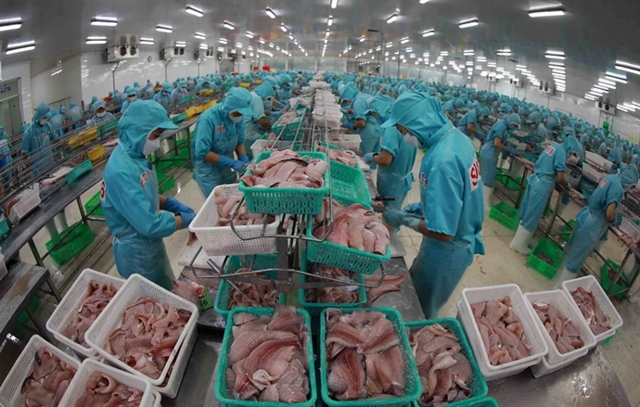Despite accounting for 19.1 per cent of Vietnam’s processing sector, the food processing industry has been struggling with major issues such as poor-quality raw materials and subpar value chain integration, said industry insiders and economists.

Workers at a fish processing factory in the southern province of Bình Dương. — Photo baochinhphu.vn
Despite accounting for 19.1 per cent of Vietnam’s processing sector, the food processing industry has been struggling with major issues such as poor-quality raw materials and subpar value chain integration, said industry insiders and economists.
They have called for greater investments in automation technology, quality management systems and human resources as foundations for the industry’s sustainable development.
They stressed the importance of small to medium-sized businesses within the industry, saying they possess limited capacity for applying the latest technologies and integrating into global supply chains, resulting in them having disadvantages against competitors.
The latest data from the General Department of Vietnam Customs said during the first eight months of this year, Vietnam’s food manufacturing and processing reported a 7.3 per cent increase in the industrial production index with a revenue increase of 7.3 per cent year-on-year, reaching VNĐ3.2 quadrillion or US$126 billion.
Sales of food and agricultural products increased by 10.2 per cent as the industry continued to improve product quality and enhance the value of Vietnamese agricultural, forestry and aquatic products.
The Southeast Asian country’s resilient agricultural, forestry and fishery sectors have played no small part, contributing over $53 billion in exports last year and a record trade surplus of $12 billion, a 43 per cent increase year over year.
Industry experts, however, have long called for the country to address the sector’s 'Achilles' heel': up to 85 per cent of Vietnam’s agricultural exports remain in raw or minimally processed forms. They cited several reasons including fragmented production, outdated processing technologies, high production costs and subpar packaging design, which have hindered Vietnamese businesses’ operations in international markets.
Key challenges for the sector included dependency on external raw material sources, insufficient labour quality and quantity, and poor logistics. Environmental concerns, financial constraints and rising land lease costs also contributed. Experts said the vast majority of businesses still employed outdated post-harvest preservation technologies.
Deputy Minister of Industry and Trade Phan Thi Thắng said consumers’ demand for sustainable, eco-friendly products has been the driving force behind Vietnamese businesses adopting newer and more advanced technologies including sustainable practices such as food safety, organic raw materials, recycling waste, reducing packaging and limiting plastic usage.
“This can be an opportunity for Vietnamese businesses and exports to grow,” she said, stressing the need to seek and form partnerships with international businesses to acquire technologies, attract investment and promote Vietnamese products.
She said the keys to sustainable growth included diversifying raw materials, modernising processing technologies, and building resilient supply chains. Collaboration between enterprises, Government bodies and research institutions is also important.
Đặng Trần Thọ from the Hanoi University of Science and Technology said greater efforts are needed to introduce modern, high-tech agriculture practices in the country’s food production and processing.
He said Vietnam must adopt and implement Internet of Things’ breakthroughs to build comprehensive training systems across the sector. Meanwhile, the Government must start introducing legal and administrative reforms to support investment in the sector. Vietnam must also adopt global standards in quality management while encouraging green agricultural practices to strengthen the sector’s competitiveness in the global market. — VNS
Read original article here